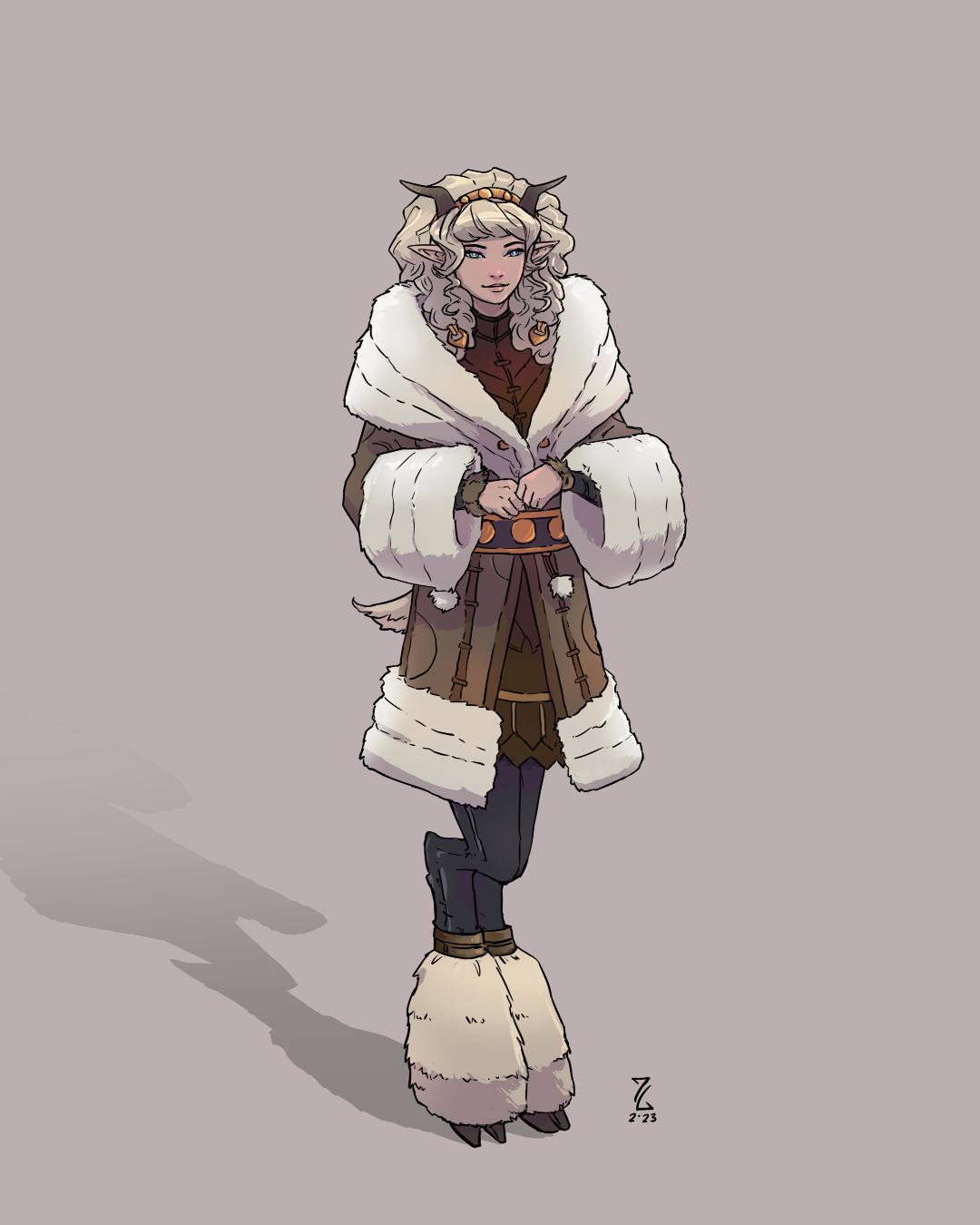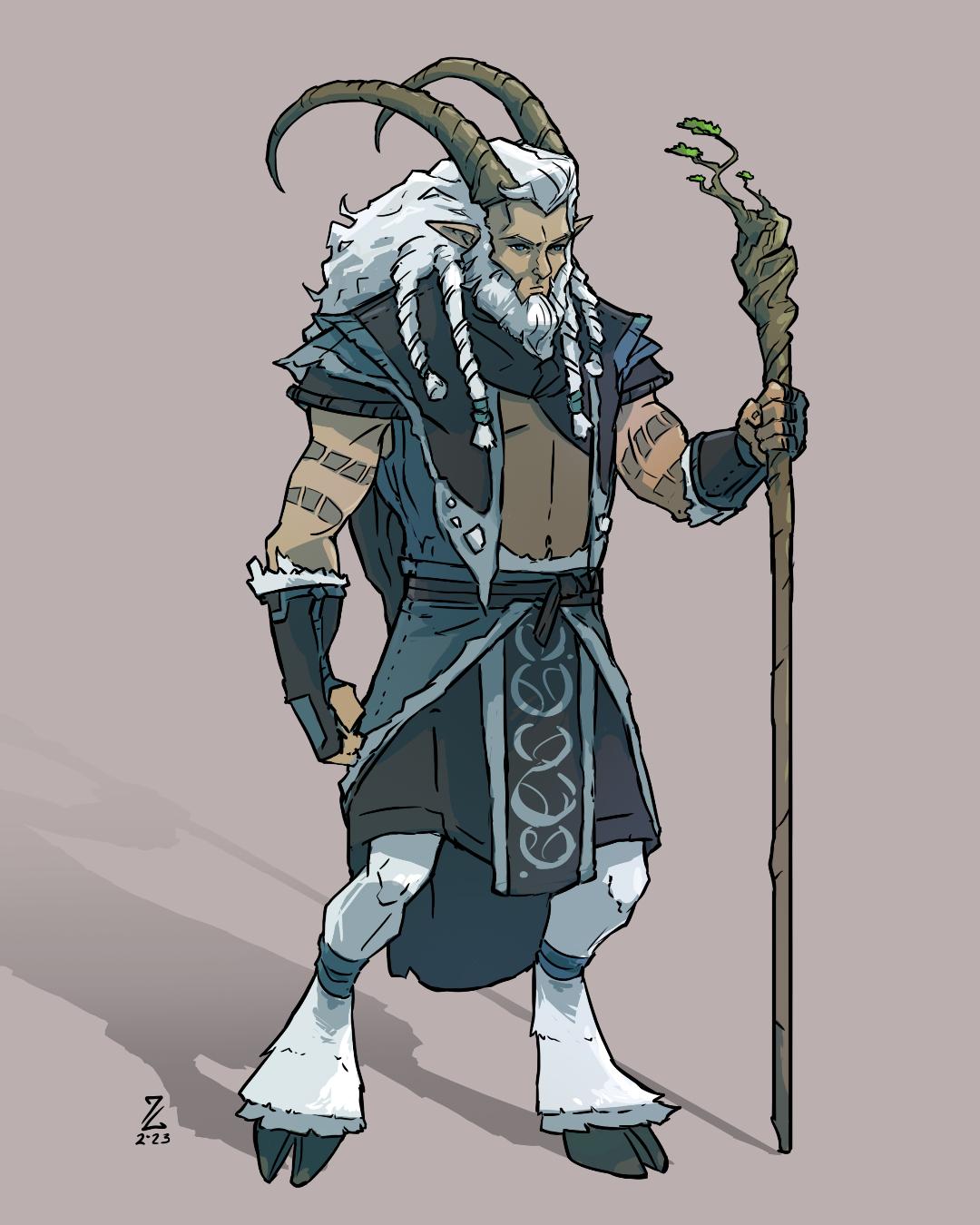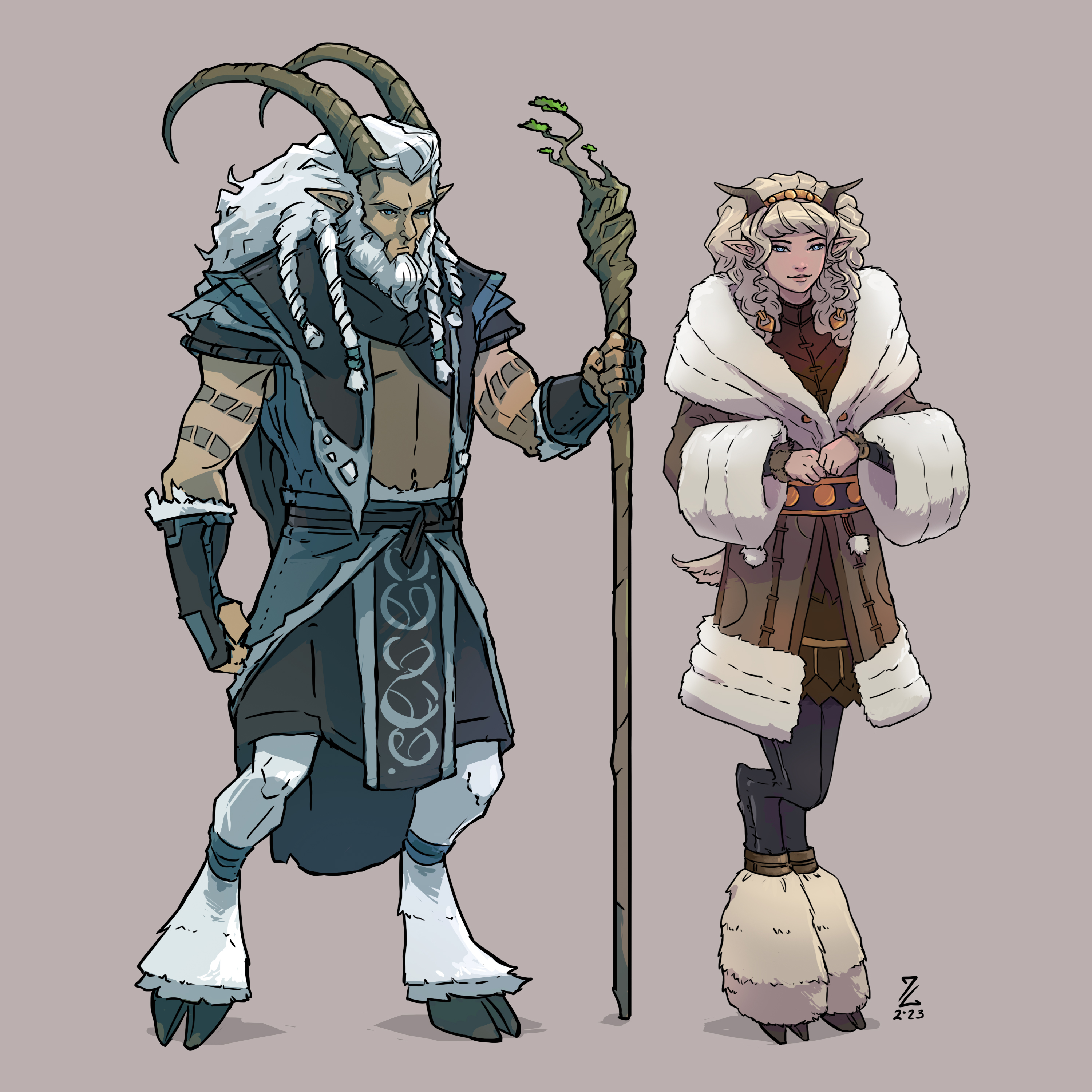Kionus satyrs
The Kionus satyrs are a relatively small population of satyrs with a wide geographic range. Sometimes nicknamed Snow Goats, the Kionus satyrs dwell primarily in the northern lands of West Colassia.
The Snow Goats are more serious and stern than most other satyrs though they still have fun hedonistic natures if you can pierce their outer shell.
 The Kionus satyrs can be found in the entire northern band of West Colassia The Great Colassian Tundra and the World Seam Mountains. They prefer rugged terrain over flat terrain so they are disproportionately represented in the mountains. They can swim, but they generally don't like water, so they usually stay inland and rarely go fishing.
The Kionus satyrs are a tough, rugged lot. They have to hunt, trap, and forage in a harsh environment and they have to compete for living space with orcs, chimera, and various other aggressive competitors in the north. They commonly keep domesticated herds of reindeer for meat or milk.
While satyrs in general are known to be fairly brave, the Kionus satyrs have a strong warrior culture that stands apart. While they will aggressively defend what is theirs, they are not blood thirsty murderers. They will negotiate peacefully with almost anyone given the chance though they prefer to do so from a position of strength.
They are more insular than most other satyrs but they are more open to dealing with outsiders than most of the mortals that roam the frozen north. If outsiders can demonstrate peaceful intentions while simultaneously demonstrating strength, the Kionus satyrs can be very generous and gregarious hosts. While they are not exactly fond of civilization, they are not hostile to civilized folk and will deal respectfully with them if approached respectfully.
They will steal to survive if pressed to it, but they are sociable and pragmatic enough to trade peacefully with almost anyone including but not limited to dwarves, orcs, humans, or kobolds.
Since they are known to deal with orcs, dwarves are often inclined to mistrust them and visa versa but they can usually overcome these misgivings with their satyr charm. But just in case their charm fails, they have their weapons. That is why they prefer to negotiate from a position of strength.
When they trade with other races, they commonly seek alcoholic beverages. Left to their own devices, their most common drink is fermented reindeer milk.
Kionus satyrs have some smiths among them, but most of their best metal weapons and tools are gained from barter or theft. When they trade with others, they commonly trade away fur, ivory, and reagents.
The Kionus satyrs can be found in the entire northern band of West Colassia The Great Colassian Tundra and the World Seam Mountains. They prefer rugged terrain over flat terrain so they are disproportionately represented in the mountains. They can swim, but they generally don't like water, so they usually stay inland and rarely go fishing.
The Kionus satyrs are a tough, rugged lot. They have to hunt, trap, and forage in a harsh environment and they have to compete for living space with orcs, chimera, and various other aggressive competitors in the north. They commonly keep domesticated herds of reindeer for meat or milk.
While satyrs in general are known to be fairly brave, the Kionus satyrs have a strong warrior culture that stands apart. While they will aggressively defend what is theirs, they are not blood thirsty murderers. They will negotiate peacefully with almost anyone given the chance though they prefer to do so from a position of strength.
They are more insular than most other satyrs but they are more open to dealing with outsiders than most of the mortals that roam the frozen north. If outsiders can demonstrate peaceful intentions while simultaneously demonstrating strength, the Kionus satyrs can be very generous and gregarious hosts. While they are not exactly fond of civilization, they are not hostile to civilized folk and will deal respectfully with them if approached respectfully.
They will steal to survive if pressed to it, but they are sociable and pragmatic enough to trade peacefully with almost anyone including but not limited to dwarves, orcs, humans, or kobolds.
Since they are known to deal with orcs, dwarves are often inclined to mistrust them and visa versa but they can usually overcome these misgivings with their satyr charm. But just in case their charm fails, they have their weapons. That is why they prefer to negotiate from a position of strength.
When they trade with other races, they commonly seek alcoholic beverages. Left to their own devices, their most common drink is fermented reindeer milk.
Kionus satyrs have some smiths among them, but most of their best metal weapons and tools are gained from barter or theft. When they trade with others, they commonly trade away fur, ivory, and reagents.
Satyrs in general have a fair amount of body hair, but Kionus satyrs are the hairiest satyr culture as befits their cold homelands. Their fur and hair tends to be white or grey. They commonly manifest either almost exclusively airy traits or have dominant airy elemental traits with secondary earthy traits.

Female Kionus Satyr by Zeta Gardner
Culture
Major language groups and dialects
Culture and cultural heritage
Like most satyrs, Kionus satyrs are musically inclined. They tend to favor drums and horns though singing is by far their favorite method of musical expression.
Shared customary codes and values
Kionus' satyrs are often honest to the point of being blunt. They have little patience for deception. They also take their oaths very seriously, a trait that sets Kionus apart from most other satyrs.
The Kionus have a tendency to cut themselves and bleed at major events, so their oaths are often blood oaths.
Common Dress code

Male Kionus Satyr by Zeta Gardner
Foods & Cuisine
Kionus satyrs rarely farm. They subsist mainly on hunting and foraging. Like many nomadic denizens of the Gmreat Colassian Tundra many Kionus tribes keep herds of reindeer but few tribes survive on reindeer exclusively.
Common Customs, traditions and rituals
Kionus satyrs are not especially pious but they still periodically give the Nine their due. They are especially fond of Maylar and Korus. While still respectful towards Nami, they are slightly less pro-Nami than most other satyrs.
Most Kionus satyrs practice ancestors worship at least a few times a year, a practice that is relatively uncommon among other other satyrs.
Kionus spiritual practices are rooted in pragmatism. Kionus give the deities much more praise if one or more of their theurgists is nearby providing helpful support and they engage in ancestor worship with more vigor if powerful spirit loas are present.
Birth & Baptismal Rites
Since their infant mortality is so high that it is considered bad luck to name a child too early. Kionus satyrs do not name their children until at least their second birthday.
On their name day, their mother (and occasionally father or another male relative) will anoint the child's head with a little bit of his/her own blood.
Coming of Age Rites
To be officially recognized as adult, young boys and girls must survive on their own for at least a week in the coldest part of winter. Usually this rite of passage is done in groups of four to six. These rites of passage often form the basis for lifelong friendships and/or romances.
Funerary and Memorial customs
Kionus satyrs are fairly similar to other satyr funeral services with a period of silence followed by a long mournful dirge followed by a raucous party.
There are two things unique to the Kionus. The first is that the bereaved usually cut their palms and bleed into a wooden cup at the start of the ceremony.
The second is that they usually practice cremation instead of burial, burning their cup of blood on the funeral pyre at the conclusion of the ceremony.
Ideals
Courtship Ideals
Most Kionus satyrs travel in bands of two dozen to five dozen satyrs but these tribal boundaries are fluid. When two groups meet, it is common for more than a few members to migrate to the other group which is the main way the Kionus avoid inbreeding issues.
Relative to other satyrs, Kionus satyrs are less likely to seek romantic partners with non-satyrs. Both male and female Kionus alike are not very monogamous as a rule but they have a tendency to prefer strong and tough mates.
Courtship rituals often involve non-lethal, but brutal fights between potential mates and/or romantic rivals.
Diverged ethnicities
Encompassed species
Related Organizations
Languages spoken
Related Locations


I like how thorough the cultural development is for the Kionus Satyrs. I especially liked the funerary customs and agricultural preferences. It was interesting. The character design is also nice. I liked the climate explanation.
I'm glad you like it! climate explanation is a big deal in Scarterra. Every mortal is influenced by the elemental forces of air, earth, fire, and water explained here. The metaphysics of elemental ethnicity If you liked the Kionus satyr character design, Zeta Gardner also made similar art for Mediterranean satyrs and he is currently working on art for the Poseidonous satyrs right now. I have other satyr herds, but I cannot afford to commission art portraits for all of them, so I used Hero Forge for the others and commissioned art for the Poseidonous, Kionus, and Mediteranean Satyrs because they are the most physically and culturally distinct and they are more likely to interact with RPG PCs and fiction protagonists than the others. All my commissioned art can be found here. Putting the "Art" in ScARTerra . Otherwise the rest of the art is created by me, is open source, or is preexisting art used with the artist's permission.